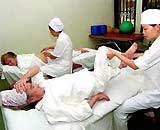About one-third of individuals who suffer from a stroke experience paralysis on one side of their body. After six months, nearly two-thirds of these patients are unable to perform daily activities independently. Therefore, even before discharge from the hospital, families must consider a rehabilitation training plan for them.
At the Hospital First Week: Assess swallowing ability and assist patients with daily living activities.
First Week: Assess swallowing ability and assist patients with daily living activities.
Week Two to Week Six: Train patients to use one hand for tasks such as dressing, bathing, and using the restroom. Encourage patients to practice with their paralyzed hand, using their shoulder and elbow to assist with gripping, holding, and pulling motions. Conduct training with supervision and assistance over distances of about 10 meters.
At Home After Hospitalization
Month One to Month Six: Encourage patients to walk for about 5 minutes daily; practice actions such as holding a cup, holding a book, folding clothes, and lifting objects of various sizes and weights. Each day, practice for about 20 minutes until the patient can perform these actions independently. If the patient cannot do it alone, assistive devices for the hands or feet can be utilized. Provide training with these devices.
Beyond Six Months: Increase walking activity. If the patient has lost their ability to speak, they should listen to and read stories from newspapers or television, and then immediately practice recounting those stories. Gradually increase the difficulty of these skills, aiming for about 20 hours of practice per week.
Approximately 20% of stroke patients experience loss of speech. Treatment for speech loss should begin early, within the first three months. Speech specialists should involve family members or volunteers during the initial training phase, as they will continue to assist the patient later on. The training duration for speech therapy should be between 40-100 hours in the first three months.
Recovery is generally observed in patients with moderate damage. For those with severe damage, recovery is nearly impossible. Patients who are paralyzed on one side must practice supportive movements, such as transferring from bed to wheelchair or moving using one hand. Engaging in intensive training with high intensity, around 16 hours or more each week, results in significantly better recovery compared to patients who only train for a few hours weekly.
Early hand exercises should commence as soon as there is a slight ability to move the hand. If there is no movement in the hand within the first six weeks, recovery is highly unlikely. Hand training should be conducted for 3-6 hours daily for about 3-6 weeks post-stroke. Electroacupuncture may help improve muscle contraction strength and assist with hand extension and flexion movements. However, if only acupuncture is performed, the improvement is less significant.
In the case of strokes, paralysis is classified into spastic and flaccid types. Most patients experience spastic paralysis, with only a small number suffering from flaccid paralysis. Patients with flaccid paralysis often face greater disabilities due to the difficulties in using their weakened limbs. In contrast, patients with spastic paralysis can utilize their arms and legs more effectively for various movements.
Walking is a common goal for all stroke patients. While hospitalized, if a patient can bend their leg, they should practice taking steps. They can train to walk short distances using crutches or with assistance from another person. To regain walking ability, even for brief distances, training is essential. Each patient should have at least 15 minutes daily dedicated to walking practice. Improvements can be seen even after three months or a year of training; however, starting early leads to better recovery outcomes.
ThS Phạm Như Hùng,
Health & Life


















































